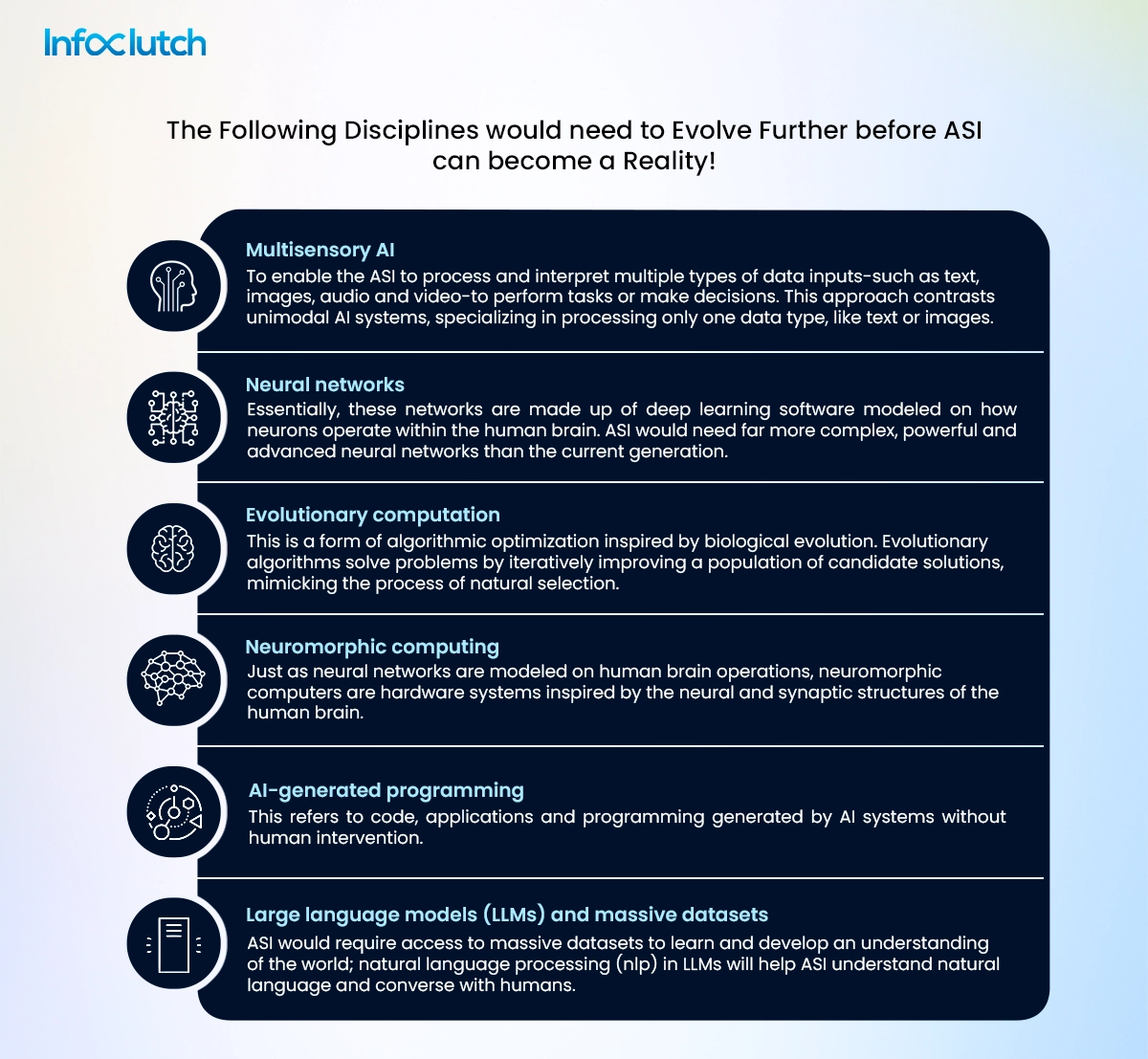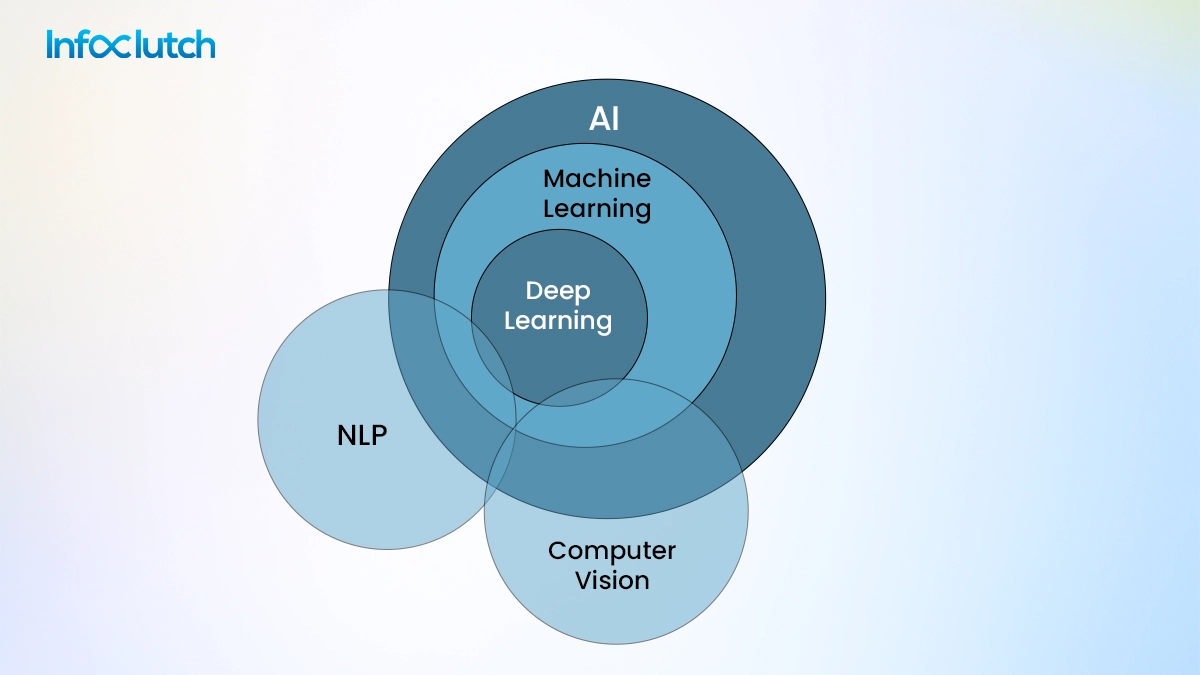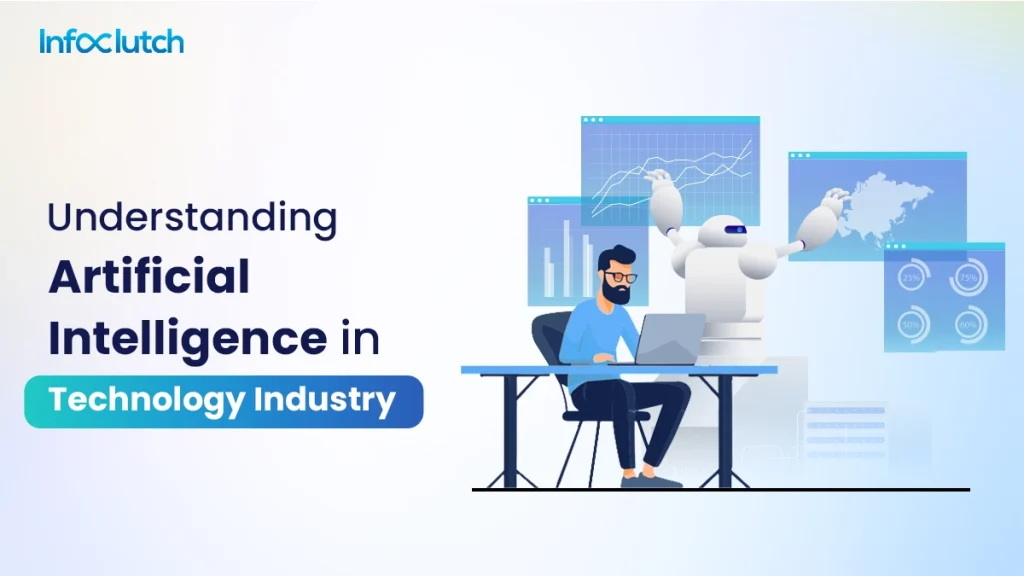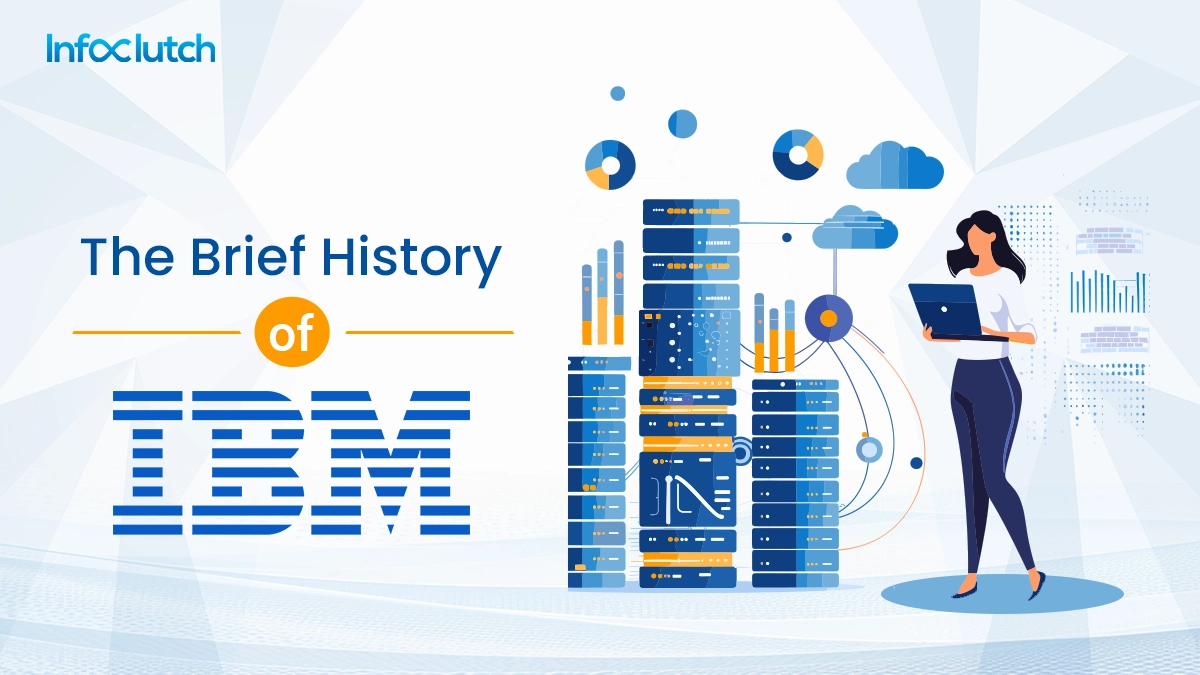Artificial Intelligence is a technology that enables machines and computers to stimulate human intelligence such as comprehension, decision making, problem solving, anatomy and creative. The market size of artificial intelligence is expected to attain a market valuation of US$826.70 Billion by 2030, growing at a CAGR of 28.46%.

Amazon, Apple, Facebook, Google, and Microsoft make investments in research and development of AI that provides promising output. Already, as per numbers, 80% of staff in the companies using AI and Automation tools report increased productivity.
AI is no longer a futuristic concept; it is something that is changing the dynamics of all industry sectors. Out of these, IT has gone through most of the changes, being at the forefront of adopting and implementing AI.
From our blog, you will learn about different types of AI, advancements made in the field of AI, challenges and advantages the tech industry will face with the advent of AI, and lastly, we will cover how AI has impacted the IT industry.
The Three types of Artificial Intelligence:
- Super intelligence: Superintelligence AI (ASI) is a theoretical concept, as superintelligent AI has to surpass all aspects of human intelligence, which ranges from problem-solving ability to creative social intelligence. Check out the image below to learn how AI has to transform itself to active superintelligence.

- General AI (Strong AI): AI, when it has the cognitive abilities of a human being, is referred to as general AI. This, too, is a theoretical concept to understand human cognitive ability, as AI has to be capable of learning, reasoning, applying knowledge, and having consciousness.
- Narrow AI (Weak AI): AI performing specific tasks, for example, chatbots, voice assistants, image recognition, and more. People use narrow AI in their day-to-day lives, 32% of companies are utilizing it, 42% organization are exploring the abilities of AI , and 35% of corporations are training and reskilling their teams to use AI.
Narrow AI is all that exist, but it is an umbrella term which has different technology segment.
Technology Segments of AIs:
In the section below, we learn about different technologies that are fueling the AI craze, enabling human beings to do things better and faster.

- Machine Learning:
Machine learning is a subset of AI. That is designed to parse data using a special algorithm. These programs have the ability modify themselves without human intervention and then produce the desired output based on analyzed data. Thus, the unique feature of ML is to analyze vast amounts of data and then perform specific tasks, enabling the global ML market to grow at a CAGR of 36.2% to hit a valuation of 225.91 Billion by 2030.
- Deep Learning:
Deep learning’s market valuation is estimated to hit a record of 638.37 Billion by 2031. The forecast highlights that technology is growing at an alarming pace; credit goes to deep learning, which is a subset of machine learning, though its capabilities are not analogous to machine learning. It uses neural networks to stimulate the complex decision-making power of the human brain. Some of the deep learning abilities are present in the artificial intelligence we use in our day-to-day lives.
- Natural language Processing:
Natural language processing (NLP) allows AI to understand and operate language as humans do. It enables computers to read and interpret spoken words with the same ease and fluidity of a human. It has two main components: natural language generation and natural language understanding. These form the essential frame work behind the chatbots and intelligent virtual assistants that communicate with the users. In future, it is expected to drive sentiment analysis and other innovations, which will push its market valuation to 158.04 billion by 2032.
- Computer Vision:
AI in Computer vision enables driving meaningful insights from videos, visual content, and digital images. From the extrapolated information, AI can make recommendations or take action. Computer vision is a symbiotic process; AI is responsible for making the computer think, and computers help the AI observe and understand. Continuous advancement is being made in this particular field, it’s an impelling fact that the computer vision market is likely to grow at a CAGR of 19.6% from 2023 to 2030.
These are the top four technology segments in AI, and the staggering market forecast indicates it is at the pivotal point of innovation. Attracting business leaders to understand in what ways AI will impact the technology industry.
Advantages provided by AI:
Despite the challenges, let’s focus on how tech and other industries can benefit from AI.
Learning and development: Natural language processing, machine learning, computer vision, and other AI technologies are used across the tech industry. All this work done by AI has to be monitored, and employees need to learn new skills, enforcing a 33% increase in AI skills across industries.
Amplified Productive: Repetitive tasks can hinder the productivity of the human workforce. AI can step in to handle monotonous tasks, liberating humans to focus on creative and strategic aspects of work. A new study suggests that when companies use AI, it enhances employee performance by 40% compared to those who don’t.
Job Creation: The fear of job displacement has spread like wildfire across industries, whereas AI is also creating new jobs. Obviously, job roles are different; for example, machine learning engineers, AI specialists, etc., 97 million new job roles will be created by AI by the year 2025, driving economic growth.
So the growth of AI in technology industry is fairly clubbed with human intelligence. This is an overview of AI’s contribution to the technology industry in particular and all the other industries in general.
Challenges Posed by AI:
Technology sector, as well as the other industry sectors will get a significant hit, with the progression made in the field of AI.
- Job Displacement: AI can replace 30% of the automated jobs, indicating that routine and few manual jobs will experience greater concerns about job security.
- Ethical Consideration: A survey was conducted among Americans ages 18 and older, and 55% of the respondents considered that AI companies do not take ethics into consideration while developing AI. Which will eventually lead to privacy concerns and bias in AI algorithms. It is a legitimate concern, and AI-developing tech companies should abide by moral ethics while creating an advanced technology that is supposed to serve the greater good.
- Skill Gap: As the technology is evolving, there is an increasing demand for employees to reskill and upskill. However, 67% of the employees say that they get less training than required on AI.
These are some of the gaps within the industry. Business leaders from numerous industries and AI- developing companies need to be innovative with their products and services to address these concerns.
Opportunities Put Forward by AI in IT:
AI is not just influencing but empowering numerous areas of the IT industry more than any other industry. Professionals with knowledge of machine learning, natural language processing, and deep learning are highly sought after today. Let’s find out more about this.
- Data Analysis: To undertake meaningful decisions, AI is used to process and analyze large volumes of data. The data is then used for data-driven marketing, to identify anomalies, and to predict trends. All of these are heavily important, as 60% of business leaders’ data governance and data analysis are immensely crucial to making data-driven information.
- Software Development: AI can automate multiple aspects of software development. Our statement is supported by a survey conducted by McKinsey, which points out that 67% of organizations have adopted some form AI in their software development processes it could be requirement analysis, bug detection, or code generation. Under AI implementation, the software development process is expedited, and the quality of the software has been enhanced.
- Cybersecurity: AI can upgrade the performance of cybersecurity software by detecting 85% of the malware threats which traditional malware software cannot detected. With AI, 12 million cybersecurity events are assessed every day, whereas humans can only assess 12,000 events. All of this is possible as AI can identify patterns faster, acquire knowledge about cyber-attacks in advance, and undertake preventative measures.
- Customer Support: 24/7 customer support is no longer a challenge as chatbots and virtual assistants can be there for the customers round the clock. Likewise, 64% of businesses predict that digital assistance improves personalized support experiences.
- IT Infrastructure: Presently, 56% of businesses are using AI to monitoring system performance and troubleshoot issues. Therefore, managing resources is a less challenging task than it usually used to be. Thanks to AI, it’s possible to automate routine tasks in IT infrastructure.
- Enterprise Architecture: AI is changing the dynamics of Enterprise Architects (EA), as 62% of them consider their demand has gone up in the market. Initial iterations of generative AI can considerably help with scenarios such as creating application documents and researching successor technologies freeing up EA’s time to work on more complex tasks, for example, implementing new systems architecture, and designing. AI’s sophisticated systems, like machine learning and neural graph networks, enhance the function of EA tools, analyze complex data, and suggest the best plan of action based on current business needs and performance metrics.
- Service Management: Automating routine tasks of ITSM (IT service management) with AI has tripled the recent times. For example, AI-powered chatbots can handle usual queries, which frees up the service desk agents to address more complex concerns. When predictive analysis is added to the process, it can anticipate issues ahead of time, improving service quality and customer satisfaction.
- Fraud Detection: Identifying patterns of inconsistencies is one of AI’s strongest suits. Another study by McKinsey indicates that AI reduces fraud detection by 30%. For instance, machine learning algorithm can learn from historical fraud data and detect fraudulent actions in real-time, thereby improving customers trust.
- Process Automation: AI automation covers up robotic process automation (RPA), which gains the ability to systematize rule-based tasks, allowing employees to focus on more critical tasks. Automation by AI refers to handling decision-making tasks by recognizing patterns in the data. On a basic level, it’s time for organizations to learn that AI can automate numerous areas, thus saving 73% of the organization’s time spend on simple manual tasks.
- Quality Assurance: AI can help detect bugs and significantly contribute to the quality assurance process of software development, making the process more effective. It also helps identify disputes in real-time and predict future performance based on historical data, pushing the efficiency of the quality assurance work by 90%.
- Operations: AIOps combines machine learning and big data to automate IT operation processes. AIOps are in extensive use for event correlation, causality determination, and anomaly detection. This is precisely the reason why the AIOps market is ripe, and it is growing at a CAGR of 01%. All of these help the IT operations manage the dynamic nature of IT architecture and the vast amount of data this system generates, thereby reducing the time and effort required to identify and resolve IT issues.
These use cases exemplify how AI is revolutionizing IT industry. The next section of the blog will take you through some of the tech giants’ AI innovations.
IT Organizations Taking Leaps with Powerful Artificial Intelligence:
Here are some examples of renowned IT companies that have successfully created and promoted AI products, services, and operations.
- OpenAI: OpenAI is making a significant contribution to AI. They use AI extensively in their research, products, and services. ChatGPT by OpenAI has taken natural language processing to the next level. ChatGPT had such prowess even in the initial days that it gained 1 million users by the 5th day of its launch.

- IBM: IBM’s AI software, Watson, has a wide-ranging functionality. It is used for cancer research and weather prediction, holding an AI market share of 02%. It also significantly contributes to AI for Operations (AIOps) by providing solutions for enhancing IT infrastructure.

- Amazon: Amazon leverages AI for fraud detection, product recommendations, and Alexa (Amazon’s virtual assistant that has 69% of the installed devices in the US market in comparison to Google, which has 25%, and Apple has 5%). Additionally, their AI is intertwined with Amazon Web Services, AI app development tools, and machine learning services.

- Microsoft: Microsoft’s popular AI products are Azure (Microsoft Azure has market share of 20% in development-tools market) and Office 365 (Microsoft Office 365 has a market share of 7.90% in applications-suite market). They are responsible for providing AI solutions for businesses, like, the no-code AI solution named AI Builder that enables businesses to build custom AI models.

- Google: Google uses AI for several products and services, including Google Assistant, YouTube recommendations, and BARD search (It has a 01% market share in the science machine learning market and data). What’s more, Google uses AI for energy usage and data center cooling.

The use of AI in the IT industry is evolving each day, which contributes to the technological development of new applications. When the future of IT is taken into consideration, AI is the heart of success.
Conclusion:
To sum it up, we emphasize that navigating the technological era requires a thorough understanding knowledge about AI. As in this new dawn of technology, AI is providing multifaceted opportunities. Tech organizations should implement continuous learning, advocate for ethical AI, and value human skills to be at par with the latest AI advancements. Organizations that meet these goals will be able to extract the optimal output from AI. AI in technology industry is not a threat; instead, when human intelligence and Artificial intelligence work together, it leads to an AI revolution.
Want to boost your business by promoting services to organizations levering artificial intelligence? Reach out to our experts today!










